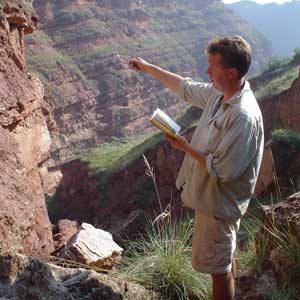|
NEWS NOTES — NEWS
Paleoclimate
Two continents, one conclusion
 |
| Wout Krijgsman of Utrecht University analyzes sedimentary cycles deposited during the Eocene-Oligocene transition from an icehouse to a greenhouse world climate. New research is suggesting that the climate change was global, not regional. Photograph is by Guillaume Dupont-Nivet. |
A sharp change in climate tens of millions of years ago was global, not regional as previously thought, according to two new studies. That could have implications for global climate change in the modern world, researchers say.
Prior to the Cenozoic-era transition that ended the Eocene epoch and opened the Oligocene 33.5 million years ago, Antarctica was a largely green environment. During this cooling period, which spanned 300,000 years, ice sheets formed on the continent, as well as on regions of the Arctic Ocean around the North Pole.
Uncertainties in rock dating and other complications, however, left researchers in the dark as to whether this cooling of the poles impacted other continents. Ocean records and circulation models of this time indicate that Antarctica’s climate was isolated and that northern continents were likely becoming warmer, not cooler. But geological and paleontological evidence from other continents suggested that they had become cooler and drier coincidentally with the polar glaciation.
Because of this seeming paradox, researchers resisted concluding that the cooling was global, even though a “fairly large volume of evidence” has been compiled suggesting just that, says Gabriel Bowen of Purdue University. “But some of the details were sketchy,” so stronger evidence was needed, he says. Now, two studies appearing Feb. 8 in Nature provide complementary findings that suggest that the polar glaciation was only one part of an episode of climate change that affected the entire globe.
In one study, a team led by Alessandro Zanazzi of the University of South Carolina looked at paleontological records from North America, where the evidence for cooling was stronger than in other places, such as Asia and Europe.
Zanazzi’s team analyzed mammalian fossil teeth and bones from the northern Great Plains dating to the late Eocene and early Oligocene. The researchers used multiple stable isotope comparisons to gain information about temperature and aridity in the region during the time the animals were alive. Fossil tooth enamel, being impervious to changes in isotopes in the surrounding environment, reflect only the isotopes present in the animals’ drinking water. Fossil bones, on the other hand, are more porous and allow in isotopes from the area where they are deposited, thus revealing more about the environment shortly after death.
The team found that together, fossils from the Eocene and the Oligocene suggested that the average annual temperature declined by about 8 degrees Celsius between the epochs, an even greater drop than ocean records from this period indicate. Such a large drop could be explained by a reverse greenhouse effect, as indicated by recently developed climate models that link the Oligocene cooling to a drop in atmospheric levels of carbon dioxide. A mass extinction took place at this time as well, Zanazzi’s team noted, and cold-blooded animals were particularly affected, perhaps suggesting that warm-blooded animals were better able to withstand cooling conditions.
In a second paper, Guillaume Dupont-Nivet of Utrecht University and colleagues examined the climate in Asia at this same time. The Eocene-Oligocene transition in Asia saw the replacement of some of the largest mammals on Earth with small rodents. In addition, soil chemistry suggested a growing dryness during the transition. But previously, these changes were linked not to the polar glaciations but to an event of closer proximity: the collision of the Asian and Indian tectonic plates, which created the highest elevations in the world — the Tibetan Plateau.
Yet when studying the sedimentary layers in these regions, Dupont-Nivet’s team discovered an abrupt disappearance of gypsum-rich layers, indicating a drying of lakes. The researchers dated the sedimentary shift using the orientation of Earth’s magnetic field that is recorded in minerals within the rocks, and found that the lakes disappeared almost exactly 34 million years ago. Getting precise dates from continental rocks — as opposed to the sea-surface temperature records that are more readily available — is invaluable, Dupont-Nivet says. “Rare continental records such as provided in our results are important to understand the different impact that climate change will have on continents,” he says.
The two studies provide new approaches to the question of ancient climate change, and both support the idea that there was a major drop in carbon dioxide levels during the Eocene-Oligocene transition that caused a worldwide climate cooling, Bowen says. Although “there’s still a lot to be worked out,” such as what caused the carbon dioxide levels to drop, he says, these findings may be relevant to the modern world. “This is another neat example from the geologic past and one of several that pretty clearly point to links between greenhouse gases and changes in global temperature.”
Links:
"Slower cooling in Oregon," Geotimes, September 2004

 Subscribe
Subscribe


